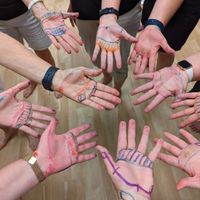If you've experienced any kind of trauma, including physical or emotional abuse, domestic violence, sexual violence, a serious accident, or combat stress, you may be experiencing symptoms of post-traumatic stress disorder (PTSD).
In this article, we are going to go over what PTSD is, its symptoms, statistics, co-occurring disorders, and explore natural and holistic treatments for PTSD.
What is PTSD?
Although PTSD was previously classified as an anxiety disorder, DSM-5 reclassified PTSD as trauma and stressor-related disorder. One of the primary characteristics of this new classification is the experience of a traumatic event, including the threat of death, an actual death, a serious injury, or sexual violence.
Many people who either experience or witness such an event may often experience memories of the event, relive the event in their mind, or experience night terrors associated with the event, which disrupts sleep.
PTSD Statistics
-
PTSD will affect between seven and eight people out of every hundred.
-
Eight million adults suffer from PTSD.
-
Women are over twice as likely to suffer from PTSD at some time in their life (10%) compared with men (4%).
PTSD Symptoms
Symptoms of PTSD may include:
-
Distressing memories: These are often recurring and involuntary memories of the traumatic event that intrude on your daily life.
-
Distressing dreams: While distressing memories may arise during the day or at night; recurring dreams of the traumatic event may disrupt sleep and may cause sleep disturbance.
-
Flashbacks: During flashbacks, a person may feel or act as if the traumatic event is happening again.
-
Distress: Feelings of distress may be triggered by internal or external cues that are associated with the traumatic event and may even cause physical reactions.
-
Avoidance: People suffering from PTSD often make an effort to avoid anything that's associated with the traumatic event and which may cause distress. This may include conversations, people, places, or activities.
-
Loss of memory: Having an inability to remember certain aspects of the traumatic event is common among people suffering from PTSD.
-
Negative beliefs: These often represent an exaggerated negative belief about one's self, others, or the world.
-
Blame: People suffering from PTSD are prone to blaming themselves or others for the traumatic event.
-
Negative emotions: These may include feelings of fear, horror, anger, guilt, or shame.
-
Lack of positive emotions: This usually manifests as an inability to experience positive emotions such as happiness, contentment, or love.
-
Irritability: Feelings of irritability may give rise to anger expressed verbally or physically.
-
Lack of social interest: Because people, places, and situations may give rise to distressing memories or flashbacks, people suffering from PTSD often find their interest in social situations or other activities diminished.
-
Hypervigilance: This is a feeling of constantly being on guard or ready for an impending traumatic event to occur.
-
Exaggerated startle response: Things that would not normally cause a person to flinch or startle may give rise to a dramatic response amongst people suffering from PTSD.
-
Inability to concentrate: Because of so many of the issues listed above, the person may suffer from an inability to concentrate.
-
Sleep disturbance: People suffering from PTSD may have difficulty falling asleep or staying asleep. They may awaken in the morning feeling like they didn't sleep at all.
What do all of these symptoms equate to in everyday life?
What is Life Like with PTSD?
Your experience may include flashbacks of the traumatic event, distressing thoughts, or nightmares. You may find yourself withdrawing from your normal life in order to avoid the traumatic memories that resurface every time you try to go out. Feelings of fear, guilt, or shame are quite common. And you may also find yourself constantly on-guard or jumpy at the slightest thing, making it difficult to just relax and enjoy life.
Co-occurring Disorders
Adults who suffer from PTSD may also suffer from:
-
Panic disorder
-
Generalized anxiety disorder
-
Social anxiety disorder
-
Agoraphobia (fear of crowded or closed spaces)
-
Obsessive-compulsive disorder
-
Personality disorder
-
Depression
PTSD and Medication
PTSD is most commonly treated with anxiety or antidepressant medications. Those co-occuring conditions can also lead to opioid prescription. According to this one study, it increases the severity of PTSD symptoms a person experiences.
In addition, many of these medications are often highly addictive.
Natural Treatment for PTSD
When it comes to holistic and natural treatment choices for PTSD, there are many options. According to this one study, none of these treatment options are addictive, and are considered safe:
Essential oils
-
Yoga
-
Exercise
-
Meditation
-
Guided meditation
-
Somatic experiencing
-
EMDR
-
Hypnotherapy
-
Acupuncture
-
EFT
Hypnotherapy for PTSD
Hypnotherapy for PTSD can be a non-invasive, holistic, and natural treatment option that can help you manage and regulate your nervous system which leads to a reduction in the severity level of PTSD symptoms. Hypnotherapy is also a treatment option where a hypnotherapist can teach you self-hypnosis so you can also use and experience the benefits of hypnotherapy anytime inside and outside of hypnotherapy sessions. Want to know how hypnotherapy works for PTSD? Read: Hypnotherapy for PTSD.
Acupuncture for PTSD
Acupuncture is an option that is available as a natural and holistic treatment option for PTSD. Through research studies and reviews, acupuncture has been documented as being beneficial for veterans, natural disaster survivors, abuse victims, and others who have experienced trauma and now live with PTSD. Want to know how? Read: Acupuncture for PTSD.
EFT
EFT is sometimes considered a type of acupuncture. Why? It uses some of the same points on the body. It is a natural treatment option that can not only be conducted by an EFT practitioner but you can also ask your EFT practitioner teach you how to it for yourself. This can be highly effective in helping yourself manage symptoms of PTSD in and outside of EFT treatment session. For more information, read: EFT and PTSD.
References:
Meier, A., Lambert-Harris, C., McGovern, M. P., Xie, H., An, M., & McLeman, B. (2014). Co-occurring prescription opioid use problems and posttraumatic stress disorder symptom severity. The American journal of drug and alcohol abuse, 40(4), 304-11. Retrieved February 5, 2019 from https://www.ncbi.nlm.nih.gov/pmc/articles/PMC4883674/
?PTSD: National Center for PTSD.? Negative Coping and PTSD - PTSD: National Center for PTSD, 5 July 2007, www.ptsd.va.gov/public/ptsd-overview/basics/how-common-is-ptsd.asp .
PTSD: National Center for PTSD. (2014, May 20). Retrieved June 18, 2018, from https://www.ptsd.va.gov/professional/treatment/overview/complementary_alternative_for_ptsd.asp
Strauss, J. L., & Lang, A. C. (2014, May 20). PTSD: National Center for PTSD. Retrieved June 18, 2018, from http://www.ptsd.va.gov/professional/treatment/overview/complementary_alternative_for_ptsd.asp
Treating Our Veterans with PTSD. (2015, January 01). Retrieved June 18, 2018, from http://www.acupuncturetoday.com/mpacms/at/article.php?id=32981
What Is Posttraumatic Stress Disorder? (n.d.). Retrieved June 18, 2018, from https://www.psychiatry.org/patients-families/ptsd/what-is-ptsd
Wahbeh, H., Senders, A., Neuendorf, R., & Cayton, J. (2014). Complementary and Alternative Medicine for Posttraumatic Stress Disorder Symptoms: A Systematic Review. Journal of evidence-based complementary & alternative medicine, 19(3), 161-175. Retrieved February 5, 2019 from https://www.ncbi.nlm.nih.gov/pmc/articles/PMC4177524/















